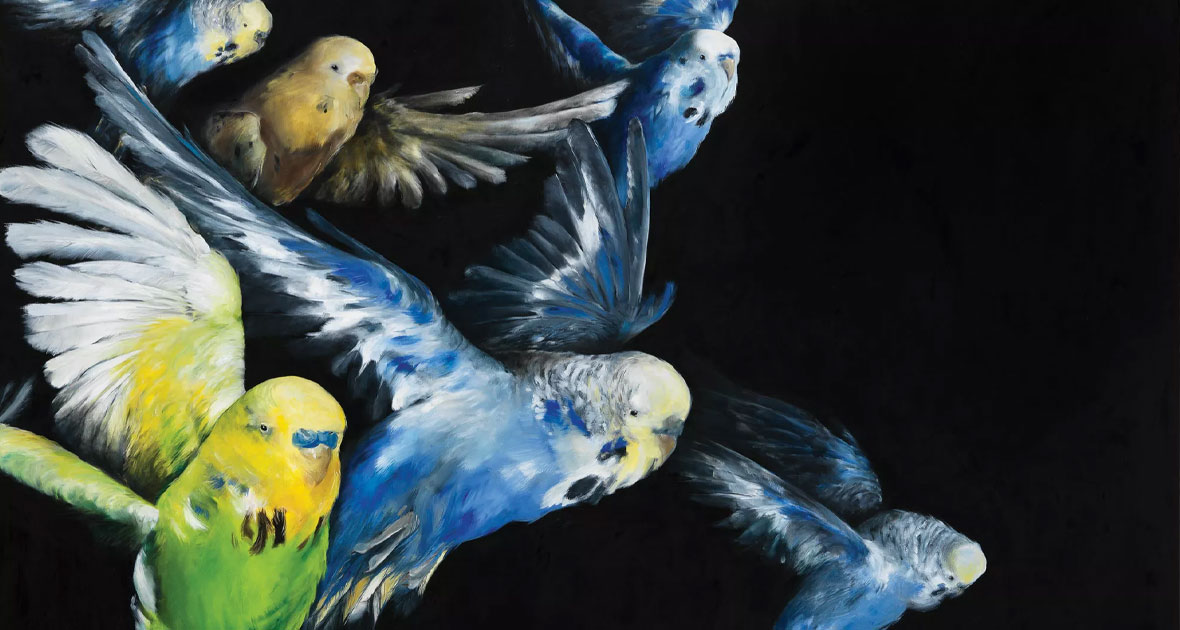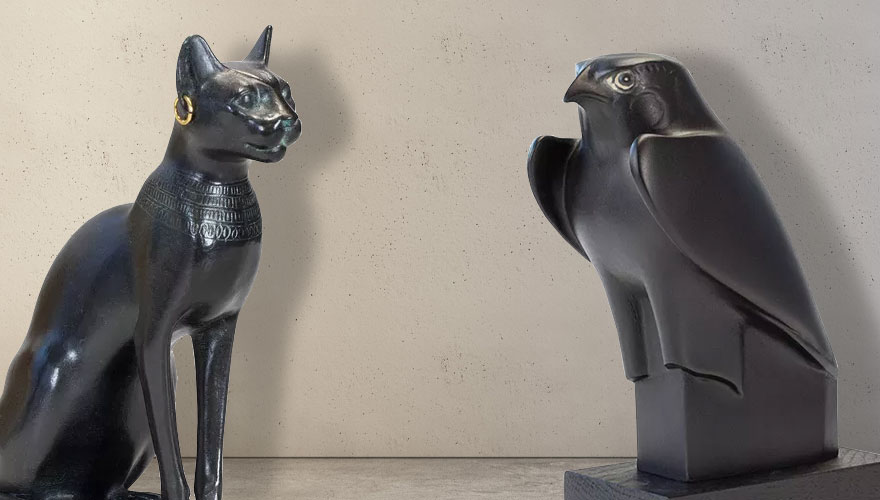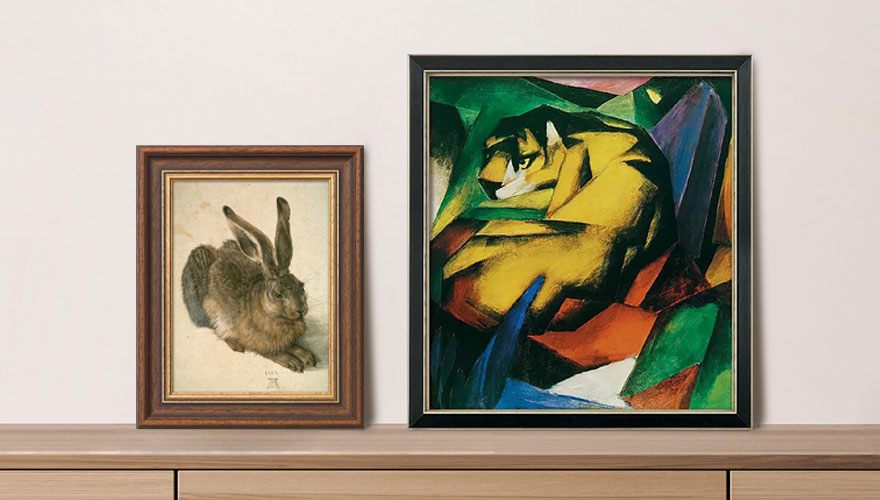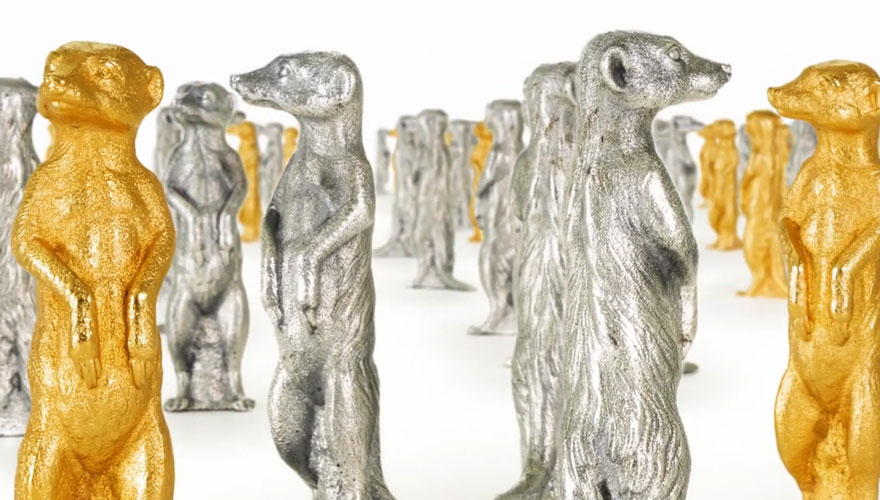
The World of Animals in Art
For many thousand years, animals have lived alongside humans - whether as working animals or pets. As a result, this relationship has given rise to a significant pictorial theme in the visual arts. Animals in art have been popular motifs for numerous centuries and have had a firm place in almost every epoch. Each generation of artists has provided its own interpretations of this subject. The spectrum of variations ranges from cave paintings and the proverbial "Roaring Stag" to stylised drawings from Classical Modernism. However, animals in art history have proven to be a highly versatile motif not only in terms of style but also regarding potential uses.
Animals in Art: From Motif to Performance Partner
Animals have been popular motifs in the visual arts for many centuries. Artists interpret the meaning and function of animals in their works in diverse ways. First and foremost, many artists - and the public - perceive animals as very aesthetically pleasing and fascinating motifs. Portraits of animals from one's homeland or distant lands have been popular in almost all major epochs. The range of representation varies from photorealistic to minimalist-abstract.

More Than a Subject: Animal Symbolism in Art
However, many artists see animals as far more than just pictorial objects in their works. They use animals in art not merely for their own sake, but to imbue them with symbolic significance. For example, animals are placed in works of art to symbolise nature in a general sense, providing a counterbalance to human civilisation. In many other contexts, however, animals also carry specific symbolic meanings. These are usually specific values or characteristics or positive/negative human traits. For example, the bull symbolises strength and courage, the fox cleverness, or the snake cunning.
Religions have also contributed to the popularity of animal artworks, assigning symbolic significance to many animals. The ancient Egyptians, for example, regarded many animals as incarnations of their gods. They used animal sculptures to honour their deities. For example, the falcon symbolised the god Horus, the cat represented the goddess Bastet, and the jackal signified the god Anubis. They were set up as large sculptures or placed next to graves in the form of statuettes.
Similarly, in the visual world of Christian religions, numerous animals hold significant symbolic value. Animals such as the dove, the snake and fish appear in many well-known Bible texts. These animals have also found their way into Christian works of art, always mindful of their biblical context and symbolism.
Animals in Performances and Happenings
However, animals in art only served as motifs. In contemporary action art from the 1960s onwards, artists began to integrate live animals into performances and happenings. Today, the performance "I like America and America likes me" by German artist Joseph Beuys is legendary. In 1974, he spent three days with a live coyote in a New York gallery. However, lifeless animal bodies have also been integrated into artistic presentations. Joseph Beuys also explained his pictures in his exhibition to a dead hare in a performance. The British artist Damien Hirst worked with animal cadavers, exhibiting, for example, a shark placed in a display case full of formaldehyde.
Animal Painting and Animal Sculptures in Art History – From Cave Decorations to an Independent Genre
Ever since humans mastered the art techniques of painting and sculpture, they began depicting animals. The oldest known depictions of animals in art are currently considered to be images of warty pigs in the caves on the Indonesian island of Sulawesi. These are said to be over 45,000 years old. However, Europe also boasts ancient cave paintings of animals, for example, from the Stone Age. These include the famous paintings in the caves of Lascaux in France, estimated to be over 35,000 years old. Early humans predominantly painted working animals and hunting animals such as mammoths, bison, deer, horses, and cows. However, the exact purpose of these wall paintings has not yet been definitively determined. Theories range from ritualistic and cultic depictions to stories accompanying the images.
From antiquity onwards, a more diverse culture of animal depictions developed in art, especially for sculpture. This can be explained by the increasing significance of animals in people's everyday lives, both as working animals and pets and in a religious context. Numerous depictions in sometimes monumental sculptures, reliefs, on papyrus, amulets or coins reflect this. However, in painting on canvas, as we know it today, animals did not initially hold a particularly prominent status. In landscape painting, genre paintings or portraits, animals in art served for a long time as mere staffage or decorative accessories.
Animals in paintings were usually in the background, merely completing nature scenes or motifs involving people, such as battles or hunting. Only around the 16th century did artists begin to centre animals as key subjects in their works. The animals in pictures became increasingly detailed, depicting various movements and also focusing on the character of the animals.
Before the invention of photography in the 19th century, animal painting also served a very practical function. For a long time, paintings and drawings were the only way to depict animals, for example, in zoological encyclopaedias and literature on biology, newspapers and magazines. Artists often took on this task, sometimes travelling to distant countries to produce pictures and drawings. By the time of Expressionism and animal painting at the beginning of the 20th century, animals had established themselves as a motif. The German painters of the "Blaue Reiter" and "Brücke" movements, in particular, devoted themselves to both native and exotic animals, painting deer, tigers and cows, among others. To this day, animals have remained a very popular subject in art, continuing to be part of the repertoire of many artists.

Famous Artists and Their Animals in Art
Many famous artists from almost all epochs also included depictions of animals in their portfolios. The German Renaissance painter Albrecht Dürer, for example, created several almost photorealistic portraits of animals - including his famous "Field Hare". The German expressionist Franz Marc was also fascinated by animals. He often spent days at the zoo and painted animal studies. His animal paintings, including those of yellow tigers, colourful cows, and blue horses, are now considered milestones of 20th-century painting.
The inventor of Cubism, Pablo Picasso, was also a great animal lover. A close friend once said, "Picasso loves or hates people, but he cares about all animals." Picasso also painted many animal pictures, including the Dove of Peace, one of his most important works. His contemporary, Marc Chagall, also repeatedly incorporated animals into his colourful fable worlds, for example, cows, sheep, and chickens.
Cats in art are also very common. Pop art icon Andy Warhol, for example, was very fascinated by cats. At times, he lived with over 20 pets in his small apartment in New York. He lovingly portrayed them in an illustrated book entitled "25 Cats Name Sam and One Blue Pussy". David Hockney was also very fond of his two dogs, Stanley and Boodgie, portraying them in numerous works. He created over 40 paintings and drawings of his "best friends".
Even Germany's most important contemporary artist, Gerhard Richter, regularly uses motifs from the animal world, painting tigers, cows, and dogs, among others, in his typical veiled style. Among the famous sculptors in art history, many were also animal lovers. Alberto Giacometti, for example, created dogs and cats with the characteristic elongated limbs. The dog sculptures by Jeff Koons, resembling balloon animals, are already considered classics of contemporary art. French artist Louise Bourgeois worked in much larger dimensions. She designed monumental spider sculptures, which she presented in various cities worldwide, including Hong Kong, Zurich, and Amsterdam.
However, the largest number of animal sculptures was probably created by Ottmar Hörl in his installations, such as the 2,000 serial lion sculptures in Munich in 2015 or the 1,000 meerkat figures at Hofgut Hohenkarpfen in 2009.

